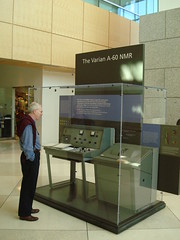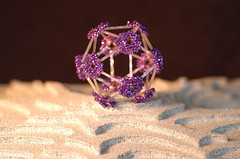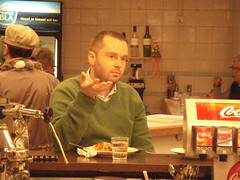Where else on earth would you, in a Metro station, find an ad like this (bacterial colonies in a petridish) for biomedical jobs?

(Medical Center Metro station, Bethesda, 29 Oct ’07)
Where else on earth would you, in a Metro station, find an ad like this (bacterial colonies in a petridish) for biomedical jobs?

(Medical Center Metro station, Bethesda, 29 Oct ’07)
The National Institutes of Health has a pretty large medical history collection, but you can’t see anything of it in any designated exhibition area. However, parts of the collection is on display in showcases around the huge NIH campus.
Here, for example, is a Varian A-60 NMR machine which was used at NIH in the 1960s on display in the lobby of the Natcher Conference Center (I asked historian of medicine David Cantor at NLM to pose as the fascinated spectator when we went for lunch last Monday):

(Btw, there is a lot of good info about NMR and the Varian A-60 on this site)
The NIH Museum displays some of their stuff around campus because they don’t have any designated exhibition space. But one can of course also make a virtue out of necessity — for example, I guess we could (with the right funding!) increase the visibility of the history contemporary biomedicine by placing selected objects in University of Copenhagen faculty and hospital buildings.
And if so, I guess it could be done somewhat more inspiring to the aesthetic senses than this particular Varian A-60 showcase. Even David who otherwise works in mid-20th century history of clinical medicine looked quite unexcited.
The Arete Initiative at The University of Chicago, led by social neuroscientist John Cacioppo, is announcing a $2 million research program on the nature and benefits of wisdom:
Once regarded as a subject worthy of the most rigorous inquiries in order to discern its nature and benefits, wisdom is currently overlooked as a topic for serious scholarly and scientific investigation in many fields. Yet it is difficult to imagine a subject more central to the human enterprise and whose exploration holds greater promise in shedding light and opening up creative possibilities for human flourishing.
I must admit that I’ve always been somewhat skeptical about the underlying motives of the John Templeton Foundation, which funds the initiative. But in this case I believe something very interesting could come out of it. The Defining Wisdom programme not only raises new and largely ignored dimensions of ethics in general, but also could help redefine bioethical research agendas.
For example it would be interesting to study to what extent current biotechnoscience and the biotech economy are compatible with eudaimonia and the classical understanding of wisdom.
In other words: current progress in biomedicine and biotech may result in better and personalised medical therapies, longer life-spans, better understanding of the structure and function of organisms and biological systems, entirely new consumer products, higher agricultural productivity, more optimal solutions to environmental problems, new and exciting ethical dilemmas, higher profits, and brand new social relations and governance strategies. But will it also increase individual flourishing and collective wisdom? And if so, how?
Isabelle Dussauge from the Royal Institute of Technology in Stockholm (see earlier post here) and a former guest in our seminar series (see here) is presenting her almost finished phd-thesis in a paper titled “Anatomy Remediated: Aligning Recent and Older Technomedical Gazes” at the National Library of Medicine, History of Medicine Division, tomorrow, Thursday 25 October:
This presentation explores the paradoxical persistence of anatomy in recent high-tech medical imaging. For instance, magnetic resonance imaging’s visuality (“the MRI-gaze”) was consecrated with a Nobel Prize in 2003 as a breakthrough in the production of crisp, but historically traditional, anatomical depictions. The development in practice of the MRI-gaze in Swedish hospitals is taken as an example throughout this presentation. It exposes how the MRI-gaze was shaped in relation to medicine’s established methods of bodily analysis and bodily production, and argues that the shaping of the MRI-gaze enacted a remediation of pathological anatomy’s body. Finally, it addresses how relations between the observer (researcher or clinician), technology, medical gazes, and the body observed were recast in that remediation process.
For our US East Coast readers: the seminar is taking place in the Lister Hill Visitors Center, Bldg 38A, Bethesda, at 2pm.
The third meeting of the Genetics and Medicine Historical Network (GMHN; see more about the network in an earlier post here) will take place in Barcelona, 30-31 May 2008, focusing on the contemporary history and public understanding of human genetics:
Some bioart leaves me quite indifferent, especially that which is perhaps better called ‘biocraftwork’. Take the exhibition ‘Crystal Structures: Viruses in Glass’ which opened last Thursday at the University of Idaho Commons Reflections Gallery. It contains a number of beaded ‘models’ of viruses — including this ‘Purple Haze’ that is said to represent the Microviridae family

— skilfully made by Holly Wichman, a professor of biological sciences at the University of Idaho who is a specialist in transposable virus elements, and Bentley Fane, a professor in the Bio5 Institute at the University of Arizona, who works on viral assembly.
‘Purple Haze’ has already been published on the cover of an issue of the Journal of Bacteriology, in the NIH Newsletter, and in the Washington Post, so it’s a good example of the usual ‘beautiful bio-pictures’-aesthetics. A few of the Wichman and Fane’s minisculptures “are meant to depict specific viruses” (representations?), somewhat like the delicate glass flowers which Raine Daston wrote about in Things that Talk (2007).
Most of the sculptures, however, just “explore a variety of viral structures with themes that range from the serious to the whimsical”. Thus some of the tailed bacteriophages are depicted as doll-like sculptures (for the fun of it?), reminiscent of art objects like Oron Catt’s tissue-engineered worry dolls, or some of the objects in the Museum of Jurassic Technology, or (especially) current knit- and quiltwork made to ‘represent’, somehow, macroanatomical structures.
Wichman and Fane also suggest that beading can sometimes help make their virological work better: “When Bentley Fane made his models of structures from T = 1 through T = 16, he discovered that some beaded structures were very stable, while others (T = 9, 12, 16) were quite unstable”. So in a sense they play around with physical models, like Watson and Crick did with their DNA-model, to see where the structural constraints are.
All this is fine, I guess — but it nevertheless leaves me pretty indifferent. Maybe I would be more engaged if I saw the actual physical work, because I very much admire craftwork (even beading). Their sculptures would be nice to have around in an exhibition on, say, invisible viruses. But would they contribute more than nicety?
(thanks to Cicada/Bioephemera for the tip!)
The Department of the History of Science at Harvard University is looking for a historian of 20th-century (and especially post-WWII) molecular biology, biotechnology, and/or the biomedical sciences. They are especially interested in candidates at earlier stages of their careers. Application deadline is December 1, 2007. More details here.
Had lunch yesterday with Lund historian of science Gustav Holmberg, author of the fine blog Det Perfekta Tomrummet (in Swedish). Gustav prefers to publish pics of things and other people (on another blog) but rarely of himself — so here at last are two portraits of Gustav, from Alfred’s pasta restaurant in Lund:
The abstracts of the two contemporary biomedicine-oriented talks at the conference ‘Re:place 2007: the Histories of Media, Art, Science and Technology’ in Berlin next month (see earlier post here) have now been put on the net, namely
Interesting papers which I believe are potentially very relevant for future contemporary biomedical history exhibition practices.
(thanks to Ingeborg for the links)
Mark Jackson, Director of the Centre for Medical History, University of Exeter, is giving a lecture in London on Wednesday 21 November on “The Stress of Life: Hans Selye and the Search for Stability”.
This is an exciting project because Selye (there is an unfinished short Wikipedia article about him) is one of the most interesting medical researchers in the 20th century, so Mark’s initiative to scrutinise his work (and life? Is there a biography in the pipeline?) is laudable. Here is the abstract of Mark’s talk:
Since the mid-20th century the notion of stress as a determinant of chronic disease has found acceptance both within psychology and clinical allergy, and within popular culture. The vocabulary of stress has thus achieved a powerful presence in everyday speech as a means of explaining the impact of work, personal history and emotional experience on health. The syndrome which came to be known as ‘stress’ was first described in 1936, by the Hungarian scientist Hans Selye (1907-82). This lecture explores the development and reception of Selye’s theories within the context of post-second world war concerns about international political stability and Selye’s own struggles for personal stability. It then evaluates the legacy of Selye’s formulation of the aetiology of chronic disease.
© 2026 Emeritus.

